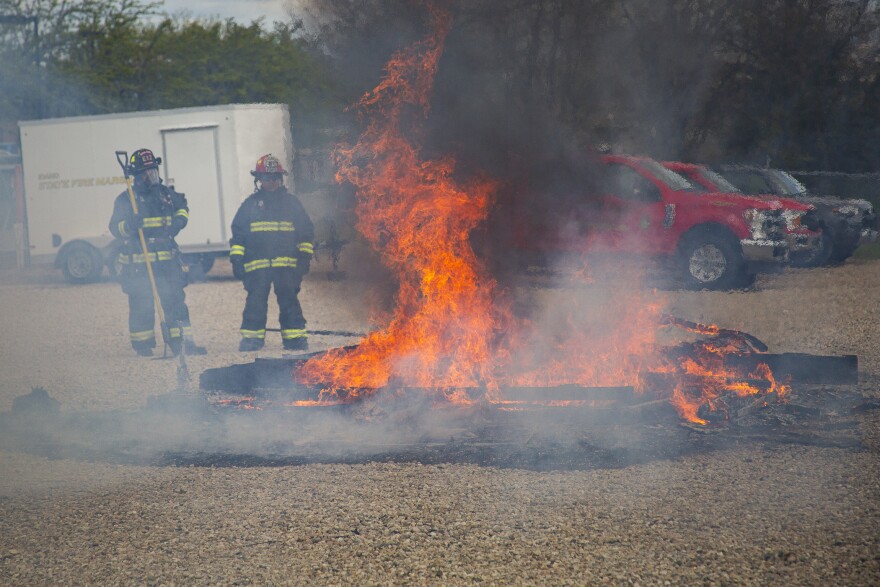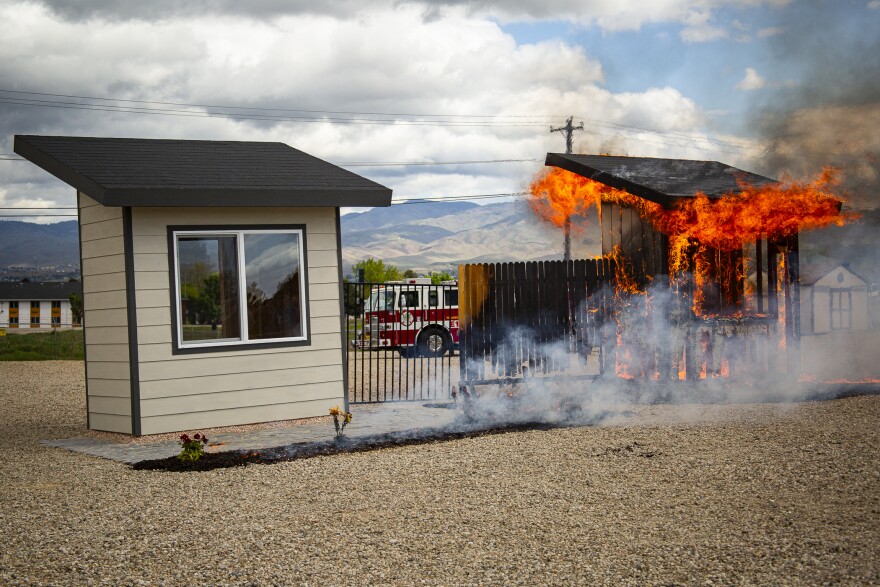It’s a nightmare scenario for many homeowners in the West: several spot fires are burning near two small homes.
The structures seem identical, but the longer you look, differences pop out. The one on the right has a wooden fence and trees up to the walls. The other has sparser landscaping farther from the home and a metal fence. Its stone walkway now serves as a non-combustible shield.
While the fire is very real, the “homes” were little more than sheds, and the “spot fires” were intentionally set with a drip torch. The late April demonstration in a gravel lot at the National Interagency Fire Center was part of a recent forum in Boise put on by the Idaho Department of Insurance, the western affiliate of the National Association of Insurance Commissioners and the Insurance Institute for Business & Home Safety (IBHS), an industry-supported nonprofit.
Anne Cope, IBHS’ chief engineer, drew the dozens of spectators' attention to “those little green gas cans that other people call shrubs.”
“They are not malnourished, they are not dead, they're green,” she said, narrating the demonstration. “And they will burn.”
From the wood mulch, the spot fires on the right spread to the trees, and from there to the fence and home itself.
“We've also seen the window frame sag and start to pull away from the structure itself, which creates the opening for embers and fire to get into the structure,” said co-narrator Steve Hawks, the institute’s wildfire director.
And then the wind gusted, whipping flames into the sky and sealing the fate of the poorly prepared home. But just a few steps away, some of the spot fires in front of the other home had mostly burned themselves out, having found little fuel to spread to. The structure seemed undamaged.

“And that's really the point of this demonstration,” Hawks said. “To give you that side-by-side view of a home that's prepared for wildfire versus one that is not.”
An uninsurable future?
While this incident was intentional and highly controlled, residents of the West have become accustomed in recent years to apocalyptic post-blaze images of homes, neighborhoods and – in some extreme cases – large swaths of whole communities reduced to blackened foundations. Experts warn that climate change’s promise of more damaging, frequent wildfires and other disasters is straining insurance markets.
“There is a growing issue concerning the cost, affordability, and general insurability of many locations across the country due to the increasing risk of exposure to climate hazards,” a September 2023 report from the First Street Foundation reads. “In the West there have been increasing costs and damage from wildfire events making their way into residential areas.”
Dave Jones – California’s insurance commissioner from 2011 to 2018 – previously told the Mountain West News Bureau that parts of the country are “marching steadily towards an uninsurable future.” A number of insurers in California have already limited coverage or stopped issuing new policies.
“We haven't had any company pull out of the state, unlike California or other places,” said Idaho Department of Insurance Director Dean Cameron. “But we're seeing them contract, we're seeing them limit their exposure, or how many homes that they will insure.”
He thinks home-hardening steps – like the fire-safe roof and landscaping that kept one of the demonstration buildings standing – can help bring premiums down.
“We think that translates into being able to keep companies there,” he said. “We have broached an idea and we're moving forward with the idea – probably this next legislative session – of creating a mitigation pool where we'll help homeowners be able to harden their homes, make sure that they've got defensible space, use appropriate siding, gutters, eaves and roof material.”
Last year, a major federal wildfire commission noted that to truly address wildfire risk, mitigation needs to happen “at the scale of entire neighborhoods or communities, not only individual parcels.”
“For this reason, the Commission recommends community-scale actions such as hazard disclosures and support for local land use planning and building codes, in addition to the provision of resources that support individual wildfire risk reduction actions to reduce future losses,” their final report continued. “These actions have the potential to positively impact insurance affordability and availability.”
Cameron would also like to see legislation address the soaring costs of reinsurance, policies that providers take out to protect against massive claims. In January, Reuters reported jumps as high as 50%in property catastrophe reinsurance rates.
Learning from catastrophe
In February, over a million acres of grassland burned in Texas – roughly half the acreage of the entire 2023 wildfire season. Hawaii’s Lahaina fire claimed just over 100 lives last year. The wind-driven Marshall Fire killed two and destroyed more than 1,000 Colorado homes in late 2021. High-ranking insurance officials from all three impacted states were on hand in Boise to share their experiences.
“The Marshall Fire is estimated to be a $2 billion event,” Jason Lapham, Colorado’s deputy commissioner for property and casualty insurance, told attendees. The state’s housing shortage only made things more complicated.
“On top of folks losing their homes, then it becomes a real struggle just to simply find a place to live,” he added.

Lapham agrees with his Idaho colleague Cameron that home and community wildfire risk mitigation is key, and noted that “good money” is spent on it. But he also said there’s an “opaqueness” in how insurance companies account for homeowners’ fire-safe improvements.
“How can they see those efforts translated in concrete ways through the insurance lens? That's the real trick,” he said. “What we're going to continue to push on at the [insurance] division in Colorado is how do we see those things more transparently reflected in the modeling that companies are using to assess the risk and ultimately decide whether or not to issue coverage to someone or how much to charge for that coverage.”
His state, like California, also has a new public insurance program for those who can’t find insurance through traditional providers. He said it’s no silver bullet, just a “backstop when folks are confronted with no other options.”
“There's not a single solution to this problem,” he said. “It's going to take kind of multiple efforts on different fronts to address this problem in a holistic way.”
A house to come home to
Back at the demo burn, Boise firefighters were tending to a pile of charred wood and ash – all that remained of one of the homes.
Asked about the prospect of better incorporating mitigation efforts into insurance pricing, Roy Wright, the insurance instititute’s CEO, said there is some movement in that direction.
In Oregon, the state legislature approved legislation last year that requires insurers to explain how they account for home hardening and other efforts, according to reporting in the Oregon Capital Chronicle. A pair of major insurers told the outlet they would not be rewarding such work. The California legislature is considering a similar measure that would also require insurers to consider landscape-scale measures like prescribed fires and fuels reduction projects in their underwriting models.
“Insurers drive their price based on risk,” Wright said. “And when risks go down, prices follow. And when price risk goes up, prices follow. We are seeing in states across the West where insurers are taking the very elements of this kind of insight: when you have bent down the risk, there is a price consideration.”

But with the smoking ash pile and one standing structure nearby, he said impacts on premiums aren’t the most important thing that mitigation can do. His parents lost their home in California’s catastrophic 2018 Camp Fire. Their insurance claim was paid, Wright recounted, but “they did not get their life back.”
“I will tell you, first and foremost, survivability is everything,” he added.
This story was produced by the Mountain West News Bureau, a collaboration between Wyoming Public Media, Nevada Public Radio, Boise State Public Radio in Idaho, KUNR in Nevada, KUNC in Colorado and KANW in New Mexico, with support from affiliate stations across the region. Funding for the Mountain West News Bureau is provided in part by the Corporation for Public Broadcasting.








